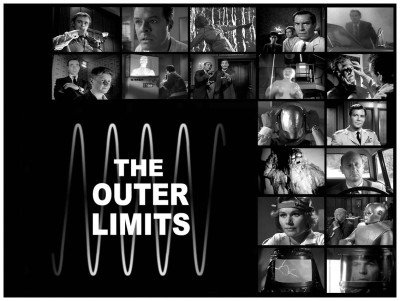 “There is nothing wrong with your television set. Do not attempt to adjust the picture. We are controlling transmission. We control the horizontal, we control the vertical. For the next hour, sit quietly and we will control what you see and hear. You are about to participate in a great adventure. You are about to experience the awe and mystery which reaches from the inner mind to…The Outer Limits.”
“There is nothing wrong with your television set. Do not attempt to adjust the picture. We are controlling transmission. We control the horizontal, we control the vertical. For the next hour, sit quietly and we will control what you see and hear. You are about to participate in a great adventure. You are about to experience the awe and mystery which reaches from the inner mind to…The Outer Limits.”
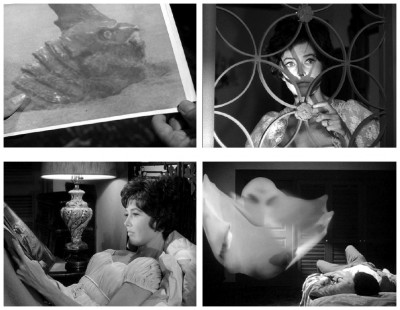 #40 WOLF 359 directed by László Benedek from a script by Seeleg Lester and Richard Landau. Working on behalf of corporate interests, scientist Jonathan Meridith (Patrick O’Neal) creates a tiny model of a distant planet known as Wolf 359 and seeds it with life in order to study planetary development. The miniaturisation allows the simulation’s evolution to advance much faster, allowing Meredith to study its evolution through an electronic microscope, and observing the birth of archaic lifeforms at its surface. A mysterious life-form evolves along with the developing experiment, a ghostly bat-like creature that is apparently aware of the scientist’s presence outside the microcosm and even acts aggressively by emitting waves of fear. At night the creature takes a physical shape in the laboratory, destroying all life there, including plants, an ant farm and a couple of guinea pigs. Becoming aware of the situation, Meridith resorts to firing his lab assistant (Dabney Coleman) and sending his wife (Sara Shane) back home, in order to keep them from harm. Pursuing his studies, the scientist soon discovers the creature seems to be a manifestation of the planet itself, like a collective mind, and bent on destruction. As the evolution of the miniature world progresses, Meridith observes a reproduction of the darkest moments of Earth’s history, including the development of nuclear weapons. One night Meridith is suddenly attacked by the creature but is saved by his wife, who arrives just in time. She breaks the miniature planet’s containment cell, causing its atmosphere to escape, subsequently causing the creature to be destroyed along with the planet. In the epilogue, Meridith records his final report on Wolf 359, saying the experiment is over and the planet destroyed, but the experience could be successful if only they could find a better planet. This is a highly original episode of The Outer Limits and, despite the strange story, it’s a compelling and worthwhile episode indeed, thanks in part to O’Neal’s nice acting. Using the ‘one second equals eleven-and-a-half days’ notion, this micro-world would age more than 2722 years in a single day. It’s also worth mentioning this episode was given The Simpsons treatment in Treehouse Of Horror VII: The Genesis Tub. Lisa performs an experiment to see if cola will dissolve a tooth and Bart shocks Lisa as part of his project to prove that nerds conduct electricity. The tooth is also electrocuted and undergoes an unusual reaction, creating a race of miniature beings. Lisa discovers this the next day and marvels at how her miniature world evolves at a rapid rate, replicating various stages of human history until it becomes a society more advanced than current humanity.
#40 WOLF 359 directed by László Benedek from a script by Seeleg Lester and Richard Landau. Working on behalf of corporate interests, scientist Jonathan Meridith (Patrick O’Neal) creates a tiny model of a distant planet known as Wolf 359 and seeds it with life in order to study planetary development. The miniaturisation allows the simulation’s evolution to advance much faster, allowing Meredith to study its evolution through an electronic microscope, and observing the birth of archaic lifeforms at its surface. A mysterious life-form evolves along with the developing experiment, a ghostly bat-like creature that is apparently aware of the scientist’s presence outside the microcosm and even acts aggressively by emitting waves of fear. At night the creature takes a physical shape in the laboratory, destroying all life there, including plants, an ant farm and a couple of guinea pigs. Becoming aware of the situation, Meridith resorts to firing his lab assistant (Dabney Coleman) and sending his wife (Sara Shane) back home, in order to keep them from harm. Pursuing his studies, the scientist soon discovers the creature seems to be a manifestation of the planet itself, like a collective mind, and bent on destruction. As the evolution of the miniature world progresses, Meridith observes a reproduction of the darkest moments of Earth’s history, including the development of nuclear weapons. One night Meridith is suddenly attacked by the creature but is saved by his wife, who arrives just in time. She breaks the miniature planet’s containment cell, causing its atmosphere to escape, subsequently causing the creature to be destroyed along with the planet. In the epilogue, Meridith records his final report on Wolf 359, saying the experiment is over and the planet destroyed, but the experience could be successful if only they could find a better planet. This is a highly original episode of The Outer Limits and, despite the strange story, it’s a compelling and worthwhile episode indeed, thanks in part to O’Neal’s nice acting. Using the ‘one second equals eleven-and-a-half days’ notion, this micro-world would age more than 2722 years in a single day. It’s also worth mentioning this episode was given The Simpsons treatment in Treehouse Of Horror VII: The Genesis Tub. Lisa performs an experiment to see if cola will dissolve a tooth and Bart shocks Lisa as part of his project to prove that nerds conduct electricity. The tooth is also electrocuted and undergoes an unusual reaction, creating a race of miniature beings. Lisa discovers this the next day and marvels at how her miniature world evolves at a rapid rate, replicating various stages of human history until it becomes a society more advanced than current humanity.
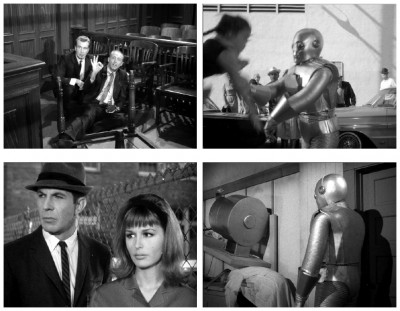 #41 I ROBOT directed by Leon Benson from a script by Robert C. Dennis and Eando Binder. Defence attorney Thurman Cutler (Howard da Silva) is coaxed out of retirement to defend a robot named Adam Link (Reed Morgan & John Caper) against the charge that it willfully murdered its creator Doctor Charles Link (Peter Brocco). On trial, Adam sits with his only friend Nina Link (Marianna Hill), the doctor’s niece. Testimony reveals that once Adam was activated he began a trial-and-error process of learning like a child. This suggests that some of his later acts, construed as violent, were in fact a matter of the mechanical man not understanding his own strength, or vague areas of human thought and emotions. Unfortunately the defence never fully recovers from the revelation that Adam read the novel Frankenstein by Mary Shelley while absorbing all the books in the doctor’s library, and the judge pronounces the robot guilty, even though the death was accidental. As Adam is taken away to be dismantled, he breaks free of his bonds to save a child from an oncoming truck, but is smashed into scrap metal in the process.
#41 I ROBOT directed by Leon Benson from a script by Robert C. Dennis and Eando Binder. Defence attorney Thurman Cutler (Howard da Silva) is coaxed out of retirement to defend a robot named Adam Link (Reed Morgan & John Caper) against the charge that it willfully murdered its creator Doctor Charles Link (Peter Brocco). On trial, Adam sits with his only friend Nina Link (Marianna Hill), the doctor’s niece. Testimony reveals that once Adam was activated he began a trial-and-error process of learning like a child. This suggests that some of his later acts, construed as violent, were in fact a matter of the mechanical man not understanding his own strength, or vague areas of human thought and emotions. Unfortunately the defence never fully recovers from the revelation that Adam read the novel Frankenstein by Mary Shelley while absorbing all the books in the doctor’s library, and the judge pronounces the robot guilty, even though the death was accidental. As Adam is taken away to be dismantled, he breaks free of his bonds to save a child from an oncoming truck, but is smashed into scrap metal in the process.
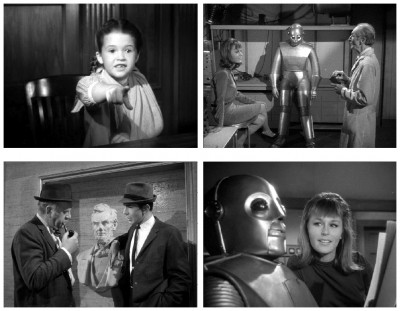 This episode is rather surprising because, unlike a typical Outer Limits story, the special effects are quite good throughout – almost as if the budget was larger than normal – which it wasn’t, and the robot costume is damn good for sixties television. An effective and interesting episode, well-written with solid performances. Many science fiction fans may be curious as to why Isaac Asimov‘s name is not attached to the project. After all, he wrote the book I Robot over a decade earlier and the episode has a lot of similarities, yet Asimov isn’t credited at all. There’s a good reason for this. The Adam Link stories written by Earl Binder with his brother Otto Binder first appeared in 1939. Adam was a sympathetic character with genuine emotions, and the tales were narrated by Adam himself. The original story ends with Adam intending to turn himself off and, although innocent, he writes his confession. In this television adaptation, screenwriter Robert C. Dennis invented the character of attorney Thurman Cutler, expanded the role of a nameless newspaperman into Judson Ellis (Leonard Nimoy) and changed Doctor Link’s relative to a woman. The ending was also changed so that Adam is found guilty – in the original story, he is vindicated and set free.
This episode is rather surprising because, unlike a typical Outer Limits story, the special effects are quite good throughout – almost as if the budget was larger than normal – which it wasn’t, and the robot costume is damn good for sixties television. An effective and interesting episode, well-written with solid performances. Many science fiction fans may be curious as to why Isaac Asimov‘s name is not attached to the project. After all, he wrote the book I Robot over a decade earlier and the episode has a lot of similarities, yet Asimov isn’t credited at all. There’s a good reason for this. The Adam Link stories written by Earl Binder with his brother Otto Binder first appeared in 1939. Adam was a sympathetic character with genuine emotions, and the tales were narrated by Adam himself. The original story ends with Adam intending to turn himself off and, although innocent, he writes his confession. In this television adaptation, screenwriter Robert C. Dennis invented the character of attorney Thurman Cutler, expanded the role of a nameless newspaperman into Judson Ellis (Leonard Nimoy) and changed Doctor Link’s relative to a woman. The ending was also changed so that Adam is found guilty – in the original story, he is vindicated and set free.
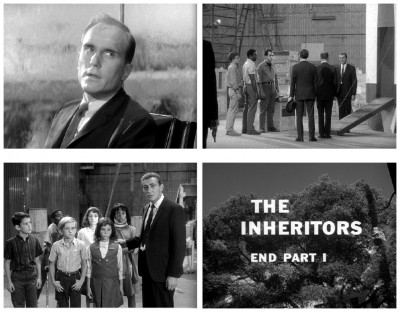 #42 THE INHERITORS (PART 1) directed by James Goldstone from a script by Seeleg Lester, Sam Neuman and Ed Adamson. Lieutenant Minns (Steve Ihnat) is shot in the head, and is operated on while government agent Adam Ballard (Robert Duvall) looks on. Minns begins to show the same brainwave patterns that three other men have shown, each one shot in the head by a bullet made from a meteorite fragment. Ballard explains to his superior (Ted De Corsia) that he believes the Earth has been invaded, and that these four men are in league with the extraterrestrials. Ballard investigates only to learn that the men are building a spaceship and that Minns has been recruiting children to take with him on a long trip. All the children are handicapped in some way: blind, deaf, mute, crippled, etc. Ballard is afraid these helpless children are being taken to be subjected to degrading studies and horrible alien experiments. This is the only two-part story in the entire series of The Outer Limits and, judging from the quality of The Inheritors, I wish they had done more two-parters. A well-written script based on solid story with good performances from all involved, including future Oscar-winner Robert Duvall and two actors who would go on to star in Hogan’s Heroes – Ivan Dixon and Leon Askin. There’s also Suzanne Cupito playing one of the kidnapped children, who changed her name to Morgan Brittany and starred in the original Dallas television series as Katherine Wentworth.
#42 THE INHERITORS (PART 1) directed by James Goldstone from a script by Seeleg Lester, Sam Neuman and Ed Adamson. Lieutenant Minns (Steve Ihnat) is shot in the head, and is operated on while government agent Adam Ballard (Robert Duvall) looks on. Minns begins to show the same brainwave patterns that three other men have shown, each one shot in the head by a bullet made from a meteorite fragment. Ballard explains to his superior (Ted De Corsia) that he believes the Earth has been invaded, and that these four men are in league with the extraterrestrials. Ballard investigates only to learn that the men are building a spaceship and that Minns has been recruiting children to take with him on a long trip. All the children are handicapped in some way: blind, deaf, mute, crippled, etc. Ballard is afraid these helpless children are being taken to be subjected to degrading studies and horrible alien experiments. This is the only two-part story in the entire series of The Outer Limits and, judging from the quality of The Inheritors, I wish they had done more two-parters. A well-written script based on solid story with good performances from all involved, including future Oscar-winner Robert Duvall and two actors who would go on to star in Hogan’s Heroes – Ivan Dixon and Leon Askin. There’s also Suzanne Cupito playing one of the kidnapped children, who changed her name to Morgan Brittany and starred in the original Dallas television series as Katherine Wentworth.
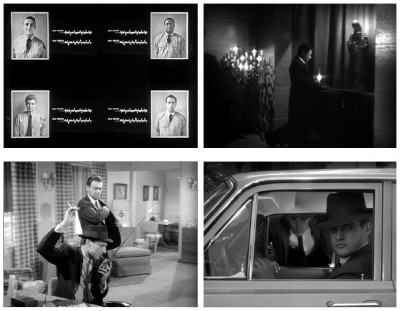 #43 THE INHERITORS (PART 2) directed by James Goldstone from a script by Seeleg Lester, Sam Neuman and Ed Adamson. Government agent Adam Ballard (Robert Duvall) continues his pursuit of Lieutenant Minns (Steve Ihnat) and his three men – Conover (Ivan Dixon), Hadley (Dee Pollock) and Renaldo (James Frawley) – all of whom are under an alien influence. Ballard finds the location where the spaceship has been built, but the four men within are sealed off by a force field which nothing can get through. Ballard begs the men to fight the enemy within their heads, turn off the force field and return the children. Three of the four men attempt to do just that, leaving it to Minns to explain the purpose of the project. The crippled children are not to be studied but cured. They will be taken to a new world where their handicaps will be healed. Indeed, the special air within the spaceship has already begun to heal them. Ballard is allowed to enter the ship to see what Minns says is true. The four men are given a choice: stay on Earth or leave without the children. They elect to leave with the children for a new world and a new life. This is the only two-part story in the entire series of The Outer Limits and, judging from the quality of The Inheritors, I wish they had done more two-parters. A well-written script based on solid story with good performances from all involved, including future Oscar-winner Robert Duvall and two actors who would go on to star in Hogan’s Heroes – Ivan Dixon and Leon Askin. There’s also Suzanne Cupito playing one of the kidnapped children, who changed her name to Morgan Brittany and starred in the original Dallas television series as Katherine Wentworth.
#43 THE INHERITORS (PART 2) directed by James Goldstone from a script by Seeleg Lester, Sam Neuman and Ed Adamson. Government agent Adam Ballard (Robert Duvall) continues his pursuit of Lieutenant Minns (Steve Ihnat) and his three men – Conover (Ivan Dixon), Hadley (Dee Pollock) and Renaldo (James Frawley) – all of whom are under an alien influence. Ballard finds the location where the spaceship has been built, but the four men within are sealed off by a force field which nothing can get through. Ballard begs the men to fight the enemy within their heads, turn off the force field and return the children. Three of the four men attempt to do just that, leaving it to Minns to explain the purpose of the project. The crippled children are not to be studied but cured. They will be taken to a new world where their handicaps will be healed. Indeed, the special air within the spaceship has already begun to heal them. Ballard is allowed to enter the ship to see what Minns says is true. The four men are given a choice: stay on Earth or leave without the children. They elect to leave with the children for a new world and a new life. This is the only two-part story in the entire series of The Outer Limits and, judging from the quality of The Inheritors, I wish they had done more two-parters. A well-written script based on solid story with good performances from all involved, including future Oscar-winner Robert Duvall and two actors who would go on to star in Hogan’s Heroes – Ivan Dixon and Leon Askin. There’s also Suzanne Cupito playing one of the kidnapped children, who changed her name to Morgan Brittany and starred in the original Dallas television series as Katherine Wentworth.
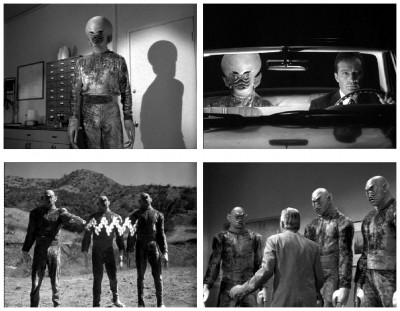 #44 KEEPER OF THE PURPLE TWILIGHT directed by Charles Haas from a script by Milton Krims and Stephen Lord. Dedicated scientist Eric Plummer (Warren Stevens) comes under the sinister influence of an alien named Ikar (Robert Webber) capable of materialising in human form, but lacking any human emotions. Acting as a scout for an invasion of Earth, Ikar studies the human race, but he is unable to comprehend emotions. Meanwhile, Plummer is trying to complete a magnetic disintegrator that converts matter into pure energy. Ikar makes a deal with Plummer: the alien offers his technical knowledge in exchange for the scientist’s ability to feel emotions. Ikar will help him complete the invention and Plummer will allow the alien to borrow his emotions. Ikar reveals that he comes from a hive world with strictly defined roles, divorced from emotion and personal identity: Scientists who think, soldiers who fight, females who reproduce, etc. Although in command of the scientist’s emotions, the alien still has difficulty understanding such things as love and beauty, concepts utterly foreign in his world. Due to the interference of Plummer’s girlfriend Janet (Gail Kobe), Ikar is unable to control or understand his emotions, which causes the experiment to backfire. Ikar’s behaviour comes to the attention of his superiors, dispatching a team of three alien soldiers to destroy Ikar, Plummer and Janet. Meanwhile, Plummer uses the alien knowledge to create a weapon capable of destroying all life. Ikar begins to feel emotions such as anger and desire, and returns the scientist’s emotions to him. Ikar is now considered a threat to the planned invasion and is pursued by his own species. Ikar kills two of the soldiers, but is unfortunately killed before Plummer can destroy the third soldier. The scientist destroys his own weapon, erasing all traces of his work and evidence of the aliens. Like many Outer Limits episodes, Keeper Of The Purple Twilight was shot on a limited budget but still manages to present an engaging story, using imagination and effort to get the job done, with a measure of philosophising. Stone-faced actors Robert Webber and Warren Stevens make for an interesting combination, and Gail Kobe’s role as Janet may seem overemotional, but it’s her nature that melts the emotionless extraterrestrial heart. I’m not exactly sure of the meaning of the title, no clue is given in the episode, but its poetic turn certainly makes it easy to remember. Purple is traditionally the colour of good judgment, purpose, spiritual fulfillment, and usually symbolises magic, mystery and royalty.
#44 KEEPER OF THE PURPLE TWILIGHT directed by Charles Haas from a script by Milton Krims and Stephen Lord. Dedicated scientist Eric Plummer (Warren Stevens) comes under the sinister influence of an alien named Ikar (Robert Webber) capable of materialising in human form, but lacking any human emotions. Acting as a scout for an invasion of Earth, Ikar studies the human race, but he is unable to comprehend emotions. Meanwhile, Plummer is trying to complete a magnetic disintegrator that converts matter into pure energy. Ikar makes a deal with Plummer: the alien offers his technical knowledge in exchange for the scientist’s ability to feel emotions. Ikar will help him complete the invention and Plummer will allow the alien to borrow his emotions. Ikar reveals that he comes from a hive world with strictly defined roles, divorced from emotion and personal identity: Scientists who think, soldiers who fight, females who reproduce, etc. Although in command of the scientist’s emotions, the alien still has difficulty understanding such things as love and beauty, concepts utterly foreign in his world. Due to the interference of Plummer’s girlfriend Janet (Gail Kobe), Ikar is unable to control or understand his emotions, which causes the experiment to backfire. Ikar’s behaviour comes to the attention of his superiors, dispatching a team of three alien soldiers to destroy Ikar, Plummer and Janet. Meanwhile, Plummer uses the alien knowledge to create a weapon capable of destroying all life. Ikar begins to feel emotions such as anger and desire, and returns the scientist’s emotions to him. Ikar is now considered a threat to the planned invasion and is pursued by his own species. Ikar kills two of the soldiers, but is unfortunately killed before Plummer can destroy the third soldier. The scientist destroys his own weapon, erasing all traces of his work and evidence of the aliens. Like many Outer Limits episodes, Keeper Of The Purple Twilight was shot on a limited budget but still manages to present an engaging story, using imagination and effort to get the job done, with a measure of philosophising. Stone-faced actors Robert Webber and Warren Stevens make for an interesting combination, and Gail Kobe’s role as Janet may seem overemotional, but it’s her nature that melts the emotionless extraterrestrial heart. I’m not exactly sure of the meaning of the title, no clue is given in the episode, but its poetic turn certainly makes it easy to remember. Purple is traditionally the colour of good judgment, purpose, spiritual fulfillment, and usually symbolises magic, mystery and royalty.
 #45 THE DUPLICATE MAN directed by Gerd Oswald from a script by Robert C. Dennis and Clifford Simak. In the far-flung future year of 2011, wealthy Henderson James (Ron Randell) has Captain Emmet (Sean McClory) smuggle an alien megasoid to Earth. It is illegal to possess a megasoid as they are highly dangerous especially during their reproductive cycle. Fast-forward to 2025, the now-pregnant megasoid escapes and hides amongst the stuffed exhibits at a nearby zoo. James, lacking the courage to track it down himself, has a clone of himself illegally made by clone bootlegger Jerichau (Steven Geray). Strict guidelines govern the production of clones, which must be destroyed before they develop memories. The clone fails its mission, the megasoid gets away, and the confused duplicate finds his way to the home of Captain Emmet. Emmet attempts to contact the police but the duplicate knocks him out. Accumulating more memories of the real James, the clone goes to what he thinks is his home. The wounded megasoid also makes its way to the James home and hides in the bushes. Duplicate James meets his wife Laura (Constance Towers), who sees in him a more youthful version of her husband before he became obsessed with the megasoid. Meanwhile, the real James has gone to bribe Emmet into killing the duplicate James once he has completed his mission. James returns home with Emmet, who is soon killed by the megasoid, and James meets his duplicate. Seeing a more compassionate version of himself gives him the courage to kill the alien, and believes Laura would be happier with the clone. James shoots the megasoid while it attacks the duplicate, only to discover that his clone was dying all the time from a time-released poison – a precaution provided by the clone bootlegger – and a less cynical James is rejoined with his wife. This is a good example of an Outer Limits episode that tries to do too much and needed to be tightened up before being filmed. It’s a shame, as the story has a lot of promise and could have been exceptional. The show could have been just about the duplicate turning out to be a better man than the original, but it gets lost among the megasoid silliness. The show could have been just about the megasoid and still be a good episode, as long as the creature didn’t look so ridiculous, which it did. The magasoid costume, which resembles a giant chicken, was re-used several years later in Lost In Space. What didn’t look ridiculous was Captain Emmet’s home, which was actually the Chemosphere, a real ‘house of the future’ built in the Hollywood Hills in 1960. Now a part of architectural history, this cultural monument can be spotted in Body Double (1984), Men In Black (1997), Charlie’s Angels (2000) and in The Simpsons as the home of Troy McClure.
#45 THE DUPLICATE MAN directed by Gerd Oswald from a script by Robert C. Dennis and Clifford Simak. In the far-flung future year of 2011, wealthy Henderson James (Ron Randell) has Captain Emmet (Sean McClory) smuggle an alien megasoid to Earth. It is illegal to possess a megasoid as they are highly dangerous especially during their reproductive cycle. Fast-forward to 2025, the now-pregnant megasoid escapes and hides amongst the stuffed exhibits at a nearby zoo. James, lacking the courage to track it down himself, has a clone of himself illegally made by clone bootlegger Jerichau (Steven Geray). Strict guidelines govern the production of clones, which must be destroyed before they develop memories. The clone fails its mission, the megasoid gets away, and the confused duplicate finds his way to the home of Captain Emmet. Emmet attempts to contact the police but the duplicate knocks him out. Accumulating more memories of the real James, the clone goes to what he thinks is his home. The wounded megasoid also makes its way to the James home and hides in the bushes. Duplicate James meets his wife Laura (Constance Towers), who sees in him a more youthful version of her husband before he became obsessed with the megasoid. Meanwhile, the real James has gone to bribe Emmet into killing the duplicate James once he has completed his mission. James returns home with Emmet, who is soon killed by the megasoid, and James meets his duplicate. Seeing a more compassionate version of himself gives him the courage to kill the alien, and believes Laura would be happier with the clone. James shoots the megasoid while it attacks the duplicate, only to discover that his clone was dying all the time from a time-released poison – a precaution provided by the clone bootlegger – and a less cynical James is rejoined with his wife. This is a good example of an Outer Limits episode that tries to do too much and needed to be tightened up before being filmed. It’s a shame, as the story has a lot of promise and could have been exceptional. The show could have been just about the duplicate turning out to be a better man than the original, but it gets lost among the megasoid silliness. The show could have been just about the megasoid and still be a good episode, as long as the creature didn’t look so ridiculous, which it did. The magasoid costume, which resembles a giant chicken, was re-used several years later in Lost In Space. What didn’t look ridiculous was Captain Emmet’s home, which was actually the Chemosphere, a real ‘house of the future’ built in the Hollywood Hills in 1960. Now a part of architectural history, this cultural monument can be spotted in Body Double (1984), Men In Black (1997), Charlie’s Angels (2000) and in The Simpsons as the home of Troy McClure.
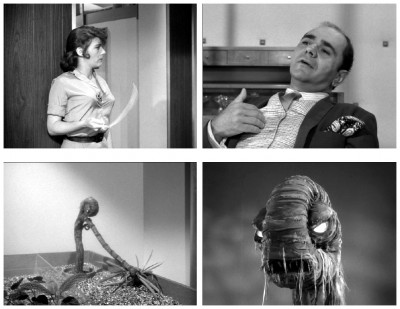 #46 COUNTERWEIGHT directed by Paul Stanley from a script by Milton Krims and Jerry Sohl. Four scientists, a journalist and an industrialist agree to spend nine months isolated during a flight simulation to the planet Antheon, a potential target for future human colonisation. But the experiment is infiltrated by an extraterrestrial presence that causes the passengers’ imagination to run wild: one finds the doll of his deceased daughter, another is almost choked to death by invisible hands. As the months pass, relations between the passengers become increasingly tense and uneasy, each being faced with their own heart of darkness. Horror escalates when shipboard plants seemingly come to life and the extraterrestrial presence incarnates itself as one of the plants, growing into a huge hideous creature. The alien eventually reveals itself to the entire crew, claiming to be one of Antheon’s indigenous inhabitants, and accuses the humans of planning to invade Antheon. After warning them to stay away from Antheon, one of the passengers hits the panic button, thus ending the simulation. Based on a short story by Jerry Sohl first published in 1959, in which an alien creature referred to as a Nilly is placed aboard a long-term space flight as a kind of scapegoat, so that the passengers will direct their anger and frustrations toward it and not each other. However, the script by Milton Krims turns this idea on its head, with a stowaway alien causing trouble amongst the passengers as it doesn’t want them to reach their destination, even though Krims changed the space flight into a mere simulation in a mock-up spaceship. Is mankind ready for travel into deep space? This episode doesn’t really answer the question as much as rephrase it.
#46 COUNTERWEIGHT directed by Paul Stanley from a script by Milton Krims and Jerry Sohl. Four scientists, a journalist and an industrialist agree to spend nine months isolated during a flight simulation to the planet Antheon, a potential target for future human colonisation. But the experiment is infiltrated by an extraterrestrial presence that causes the passengers’ imagination to run wild: one finds the doll of his deceased daughter, another is almost choked to death by invisible hands. As the months pass, relations between the passengers become increasingly tense and uneasy, each being faced with their own heart of darkness. Horror escalates when shipboard plants seemingly come to life and the extraterrestrial presence incarnates itself as one of the plants, growing into a huge hideous creature. The alien eventually reveals itself to the entire crew, claiming to be one of Antheon’s indigenous inhabitants, and accuses the humans of planning to invade Antheon. After warning them to stay away from Antheon, one of the passengers hits the panic button, thus ending the simulation. Based on a short story by Jerry Sohl first published in 1959, in which an alien creature referred to as a Nilly is placed aboard a long-term space flight as a kind of scapegoat, so that the passengers will direct their anger and frustrations toward it and not each other. However, the script by Milton Krims turns this idea on its head, with a stowaway alien causing trouble amongst the passengers as it doesn’t want them to reach their destination, even though Krims changed the space flight into a mere simulation in a mock-up spaceship. Is mankind ready for travel into deep space? This episode doesn’t really answer the question as much as rephrase it.
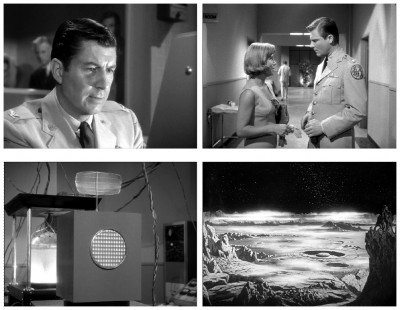 #47 THE BRAIN OF COLONEL BARHAM directed by Charles Haas from a script by Robert C. Dennis and Sidney Ellis. Experienced astronaut Colonel Barham (Anthony Eisley) is restricted to a wheelchair, suffering from advance stage leukemia, and has been chosen to complete one final mission, an assignment that will require his living brain to be transferred into a computer-controlled robotic device. Barham will still be able to think, see and hear, yet be free from such human physical needs as eating and sleeping. Indifferent toward his marriage and long-suffering wife Jennifer (Elizabeth Perry), Barham actually welcomes the idea of being isolated from her and his fellow NASA project members. The mission involves sending an American space probe containing Colonel Barham’s brain to Mars, thereby winning the Cold War space-race against the Soviet Union. Project psychiatrist McKinnon (Grant Williams) warns that subconscious drives may be released and that the egocentric Barham may be the wrong choice for such a radical experiment, but project leader General Pettit (Douglas Kennedy) insists the space-race takes precedence, so the experiment proceeds, despite eerie developments. Barham’s sociopathic emotions begin to affect the computerised contraption and a malformation soon appears: jealous feelings towards his wife’s relationship with McKinnon. Jennifer explains that her husband had been unfaithful and, as his isolated brain becomes increasingly more megalomanic, there’s the possibility that the ‘new’ Barham will became a danger to others, that he might somehow be able to take control of the minds of nearby humans. While hardly the best of the series, The Brain Of Colonel Barham was very well-received upon release, at a time when the so-called space-race was still in its infancy. Well-directed by Charles Haas, the storyline is just one of many inspired by Donovan’s Brain (1953) based on the novel by Curt Siodmak. Although such a plot has little need for special effects, the effects employed here are more than acceptable, with first rate cinematography by Kenneth Peach. With such a studio-bound story, the work depends upon the proficiency of the performers and, for the most part, these are impressive, although a better script is called for.
#47 THE BRAIN OF COLONEL BARHAM directed by Charles Haas from a script by Robert C. Dennis and Sidney Ellis. Experienced astronaut Colonel Barham (Anthony Eisley) is restricted to a wheelchair, suffering from advance stage leukemia, and has been chosen to complete one final mission, an assignment that will require his living brain to be transferred into a computer-controlled robotic device. Barham will still be able to think, see and hear, yet be free from such human physical needs as eating and sleeping. Indifferent toward his marriage and long-suffering wife Jennifer (Elizabeth Perry), Barham actually welcomes the idea of being isolated from her and his fellow NASA project members. The mission involves sending an American space probe containing Colonel Barham’s brain to Mars, thereby winning the Cold War space-race against the Soviet Union. Project psychiatrist McKinnon (Grant Williams) warns that subconscious drives may be released and that the egocentric Barham may be the wrong choice for such a radical experiment, but project leader General Pettit (Douglas Kennedy) insists the space-race takes precedence, so the experiment proceeds, despite eerie developments. Barham’s sociopathic emotions begin to affect the computerised contraption and a malformation soon appears: jealous feelings towards his wife’s relationship with McKinnon. Jennifer explains that her husband had been unfaithful and, as his isolated brain becomes increasingly more megalomanic, there’s the possibility that the ‘new’ Barham will became a danger to others, that he might somehow be able to take control of the minds of nearby humans. While hardly the best of the series, The Brain Of Colonel Barham was very well-received upon release, at a time when the so-called space-race was still in its infancy. Well-directed by Charles Haas, the storyline is just one of many inspired by Donovan’s Brain (1953) based on the novel by Curt Siodmak. Although such a plot has little need for special effects, the effects employed here are more than acceptable, with first rate cinematography by Kenneth Peach. With such a studio-bound story, the work depends upon the proficiency of the performers and, for the most part, these are impressive, although a better script is called for.
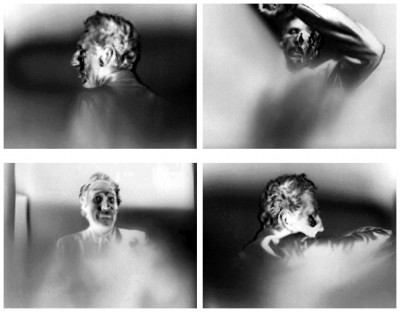 #48 THE PREMONITION directed by Gerd Oswald from a script by Sam Roeca and Ib Melchior. Test pilot Jim Darcy (Dewey Martin) and his wife Linda (Mary Murphy) become trapped ten seconds ahead in time, enabling them to witness time unfold at the rate of about one second every thirty minutes. In the time they have left before re-syncing with normal time, they see their daughter Janie (Emma Tyson) is about to be hit by truck whose handbrake had not been set properly. The parents’ inability to move objects in the ‘real’ world prevents them from resetting the handbrake or pulling Janie out of danger. Furthermore, they learn that when time ‘catches up’ with them, they have to be in the exact positions they were five hours earlier when time froze. They meet an unnamed malevolent individual (Kay E. Kuter) who had experienced the same situation but failed to make it back in time, becoming trapped in a sort-of negative ‘limbo’. When he reveals that he could take from them their chances to return to reality, Jim and Linda understand how grave their situation is – one or both could end up being stuck in this state forever. Jim soon discovers he can now move and manipulate certain items, and hits upon a way to save his daughter from death. He removes seatbelts from his wife’s car and ties them to the back wheel of the slow-moving truck. He ties the other end around the handbrake so that the brakes will engage the second the time warp ends. Jim and Linda hurry back to the crash site and assume their original positions. When time catches up, the seatbelt pulls the handbrake stopping the truck, their daughter is safe and the world returns to normal. It may not be the best episode of the series, but it’s not half bad either. The math doesn’t quite work, but it’s still a compelling concept, and the execution is efficient to say the least. The effects are convincing, though you can clearly tell what is stock footage, and the loud high-pitched soundtrack music is downright annoying. Unfortunately, the patriarchal values of the era are a real drawback. Jim comes across as a complete jerk, and Linda gets extremely upset and is largely useless. This becomes quite grating, making an otherwise fine episode almost intolerable. Recommended, just beware of the chauvinistic themes. Also recommended is The Lost Hour, an episode of the television comedy series Eerie Indiana produced by Joe Dante and directed by Bob Balaban, in which Marshall (Omri Katz) neglects to set his watch back an hour during daylight savings. When he wakes up the next day, he finds himself all alone, except for a scared teenage girl (Nikki Cox) and a group of garbagemen who want the two of them dead.
#48 THE PREMONITION directed by Gerd Oswald from a script by Sam Roeca and Ib Melchior. Test pilot Jim Darcy (Dewey Martin) and his wife Linda (Mary Murphy) become trapped ten seconds ahead in time, enabling them to witness time unfold at the rate of about one second every thirty minutes. In the time they have left before re-syncing with normal time, they see their daughter Janie (Emma Tyson) is about to be hit by truck whose handbrake had not been set properly. The parents’ inability to move objects in the ‘real’ world prevents them from resetting the handbrake or pulling Janie out of danger. Furthermore, they learn that when time ‘catches up’ with them, they have to be in the exact positions they were five hours earlier when time froze. They meet an unnamed malevolent individual (Kay E. Kuter) who had experienced the same situation but failed to make it back in time, becoming trapped in a sort-of negative ‘limbo’. When he reveals that he could take from them their chances to return to reality, Jim and Linda understand how grave their situation is – one or both could end up being stuck in this state forever. Jim soon discovers he can now move and manipulate certain items, and hits upon a way to save his daughter from death. He removes seatbelts from his wife’s car and ties them to the back wheel of the slow-moving truck. He ties the other end around the handbrake so that the brakes will engage the second the time warp ends. Jim and Linda hurry back to the crash site and assume their original positions. When time catches up, the seatbelt pulls the handbrake stopping the truck, their daughter is safe and the world returns to normal. It may not be the best episode of the series, but it’s not half bad either. The math doesn’t quite work, but it’s still a compelling concept, and the execution is efficient to say the least. The effects are convincing, though you can clearly tell what is stock footage, and the loud high-pitched soundtrack music is downright annoying. Unfortunately, the patriarchal values of the era are a real drawback. Jim comes across as a complete jerk, and Linda gets extremely upset and is largely useless. This becomes quite grating, making an otherwise fine episode almost intolerable. Recommended, just beware of the chauvinistic themes. Also recommended is The Lost Hour, an episode of the television comedy series Eerie Indiana produced by Joe Dante and directed by Bob Balaban, in which Marshall (Omri Katz) neglects to set his watch back an hour during daylight savings. When he wakes up the next day, he finds himself all alone, except for a scared teenage girl (Nikki Cox) and a group of garbagemen who want the two of them dead.
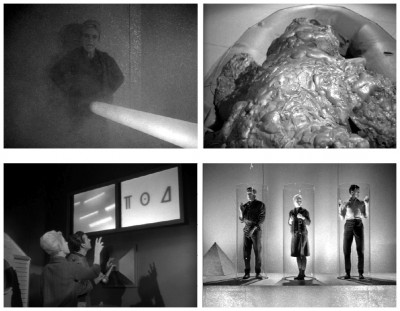 #49 THE PROBE directed by Felix Feist from a script by Seeleg Lester and Sam Neuman. When an airplane crashes into the sea during a hurricane, four survivors – pilot Coberly (Ron Hayes) and passengers Jefferson (Peter Mark Richman), Amanda (Peggy Ann Garner) and Dexter (William Stevens) – make their way through thick fog on an inflatable life-raft. At first they think they’re in the eye of the hurricane, until they run aground, no longer floating on the ocean, but sitting on a foggy floor surface in a large metal chamber. It seems they were scooped up by an alien space probe that was taking water samples. A cold-light beam falls on Dexter who is literally frozen until the others push him out of the light. Dexter stays with the raft while the others explore the inside of the probe. Once alone, Dexter is attacked and consumed by what looks like a giant mutant microbe, larger than a man. The three survivors eventually find the bridge of the alien ship and confirm that the probe is drawing up seawater. Jefferson is reminded of the space probes Earth has sent to study nearby planets, and surmises that their raft was subjected to alien testing and simply got in the way. Checking the data, Jefferson surmises that the probe is from Venus and uses some sort of space-warp drive. They see a screen transmitting symbols, and Jefferson tries to communicate by altering the sequence of the alien symbols. Soon the giant microbe arrives, but it becomes trapped in the alien’s cold-light beam. The alien machinery starts humming loudly as the probe prepares to take-off. Jefferson and Amanda continue to figure out the alien symbols while Coberly is enveloped by the mist and disappears. Jefferson goes look for Coberly and he too disappears into the fog. Amanda starts to plead for mercy, begging the aliens to understand their predicament. She begins to panic and follows the others. In the heavy mist, Amanda is probed by the alien light-beam, and soon finds herself outside on the life-raft, re-united with Jefferson and Coberly. A rescue plane soon arrives and Amanda wonders if she succeeded in getting through to the aliens, while they watch the space probe fly off and self-destruct. After a relatively short run, The Outer Limits ended with this particular episode. While not exactly brilliant, it is intriguing and ends well. Its themes of alien life and compassion are consistent with the show and make for an interesting finale. By the way, Peggy Ann Garner, who played Amanda, had made quite a name for herself as a child actress in films like A Tree Grows In Brooklyn (1945) two decades earlier, for which she received a special Oscar.
#49 THE PROBE directed by Felix Feist from a script by Seeleg Lester and Sam Neuman. When an airplane crashes into the sea during a hurricane, four survivors – pilot Coberly (Ron Hayes) and passengers Jefferson (Peter Mark Richman), Amanda (Peggy Ann Garner) and Dexter (William Stevens) – make their way through thick fog on an inflatable life-raft. At first they think they’re in the eye of the hurricane, until they run aground, no longer floating on the ocean, but sitting on a foggy floor surface in a large metal chamber. It seems they were scooped up by an alien space probe that was taking water samples. A cold-light beam falls on Dexter who is literally frozen until the others push him out of the light. Dexter stays with the raft while the others explore the inside of the probe. Once alone, Dexter is attacked and consumed by what looks like a giant mutant microbe, larger than a man. The three survivors eventually find the bridge of the alien ship and confirm that the probe is drawing up seawater. Jefferson is reminded of the space probes Earth has sent to study nearby planets, and surmises that their raft was subjected to alien testing and simply got in the way. Checking the data, Jefferson surmises that the probe is from Venus and uses some sort of space-warp drive. They see a screen transmitting symbols, and Jefferson tries to communicate by altering the sequence of the alien symbols. Soon the giant microbe arrives, but it becomes trapped in the alien’s cold-light beam. The alien machinery starts humming loudly as the probe prepares to take-off. Jefferson and Amanda continue to figure out the alien symbols while Coberly is enveloped by the mist and disappears. Jefferson goes look for Coberly and he too disappears into the fog. Amanda starts to plead for mercy, begging the aliens to understand their predicament. She begins to panic and follows the others. In the heavy mist, Amanda is probed by the alien light-beam, and soon finds herself outside on the life-raft, re-united with Jefferson and Coberly. A rescue plane soon arrives and Amanda wonders if she succeeded in getting through to the aliens, while they watch the space probe fly off and self-destruct. After a relatively short run, The Outer Limits ended with this particular episode. While not exactly brilliant, it is intriguing and ends well. Its themes of alien life and compassion are consistent with the show and make for an interesting finale. By the way, Peggy Ann Garner, who played Amanda, had made quite a name for herself as a child actress in films like A Tree Grows In Brooklyn (1945) two decades earlier, for which she received a special Oscar.
 The Outer Limits was too good to have lasted less than two seasons. The network inexplicably killed the show by moving it to an impossible time slot, even though the show was initially quite popular. Thanks goes to Wikipedia for certain information, and a big thanks to David J. Schow and Jeffrey Frentzen, authors of the definitive tome The Outer Limits Official Companion (Ace SF 1986), one of the first best television episode guide books ever to be published. If you have any interest in the early formative days of American television, this volume should definitely be near the top of your list. Anyway, please join me next week when I have the opportunity to inflict upon you the tortures of the damned from that dark, bottomless pit known as Hollywood for…Horror News! Toodles!
The Outer Limits was too good to have lasted less than two seasons. The network inexplicably killed the show by moving it to an impossible time slot, even though the show was initially quite popular. Thanks goes to Wikipedia for certain information, and a big thanks to David J. Schow and Jeffrey Frentzen, authors of the definitive tome The Outer Limits Official Companion (Ace SF 1986), one of the first best television episode guide books ever to be published. If you have any interest in the early formative days of American television, this volume should definitely be near the top of your list. Anyway, please join me next week when I have the opportunity to inflict upon you the tortures of the damned from that dark, bottomless pit known as Hollywood for…Horror News! Toodles!
 Horror News | HNN Official Site | Horror Movies,Trailers, Reviews
Horror News | HNN Official Site | Horror Movies,Trailers, Reviews
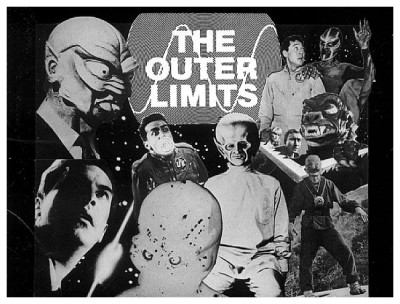
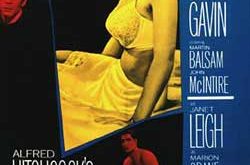


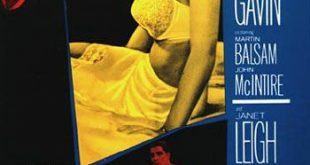

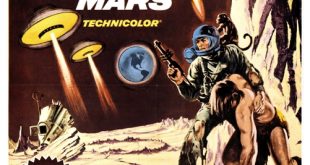
THE OUTER LIMITS WAS AWESOME I WISH IT HAD MORE THAN 2 SEASONS